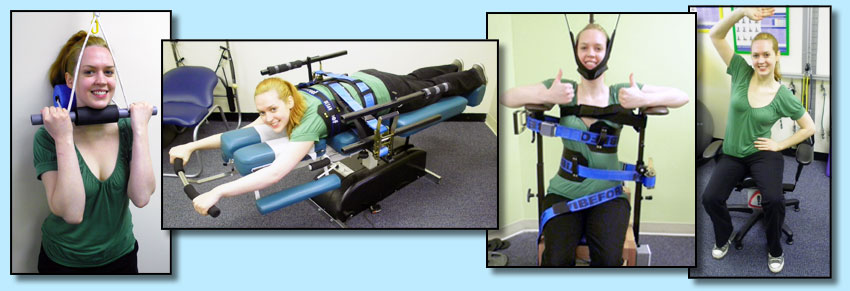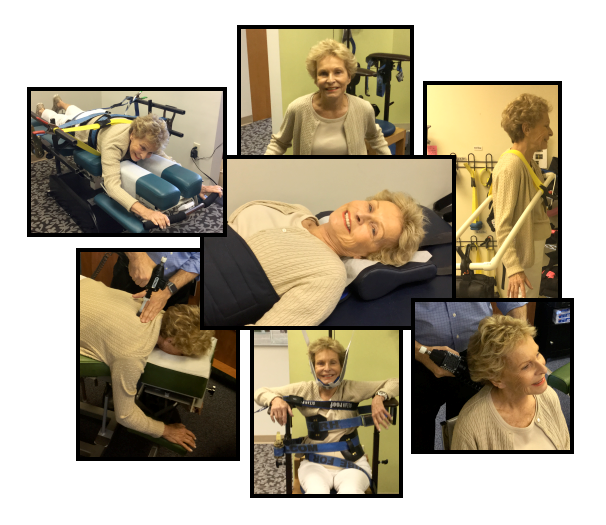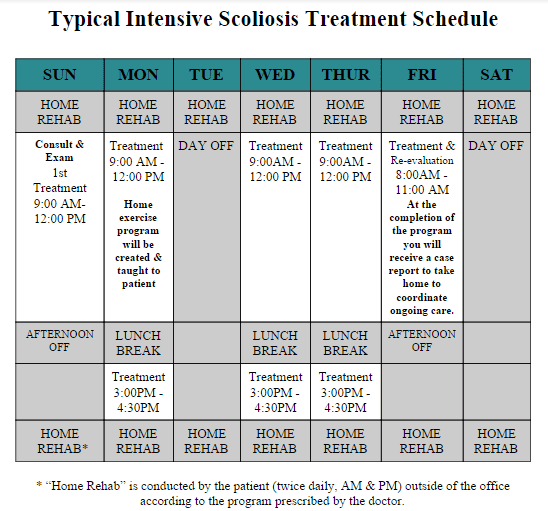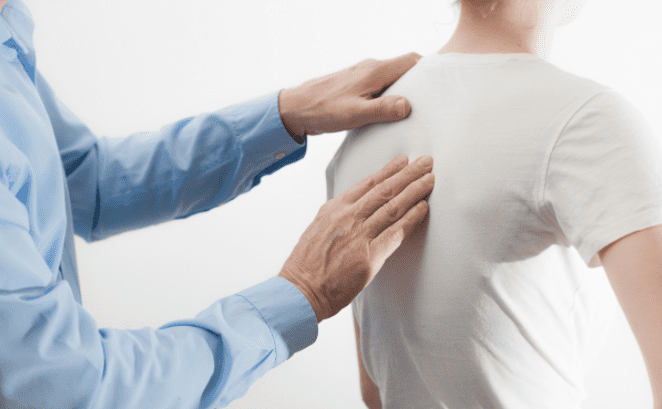
Are you a parent whose child has mild scoliosis? Have you been told by an orthopedist that it may get worse, but that all you can do is “watch and wait” to see what happens?
Or are you an an adult who suffers from mild scoliosis? Do you experience pain but have been instructed by your doctor to do nothing because it is “too small to treat”?
If you relate to any of the above, then this article is for you. The Strauss Scoliosis Correction team has helped thousands of patients stabilize and reverse mild-scoliosis. To jump to a section, please use the table of contents below
What is Mild Scoliosis?
Any spinal curve greater or equal to 10 degrees is considered to be scoliosis.
Mild scoliosis, in particular, is defined as a curve between 10 and 20 degrees.
Mild scoliosis can be broken down further into different categories, and your doctor may have mentioned one of these as part of your diagnosis.
- Mild scoliosis in the thoracic spine occurs in the mid back (thoracic) and is typically diagnosed in children or teens.
- Mild scoliosis of the lumbar spine occurs in the lower back (lumbar) and is more common in adults.
- Mild levoscoliosis signifies that the spine curves to the left.
- Mild dextroscoliosis signifies that the spine curves to the right. The terms dextro and levo can be combined with the region of the spine, so “mild thoracic dextroscoliosis” means a small spinal curve to the right, in the middle of the spine.
- Mild Kyphosis is a slight outward curve causing an excessive rounding of the back.
Another term you may come across frequently is idiopathic, and in particular, adolescent idiopathic scoliosis. The word idiopathic indicates that there is no specified cause for the scoliosis, which is the most frequent type of scoliosis that is diagnosed. Adolescent idiopathic scoliosis simply means that it is an idiopathic scoliosis that first occurred in an adolescent (aged 10-18).
Mild Scoliosis Symptoms
Most often Mild Scoliosis may show no noticeable outward signs or symptoms and can go undiagnosed for years. Many of the signs or symptoms of mild scoliosis will involve subtle postural and body symmetry changes.
Symptoms of mild scoliosis include:
- Scoliosis curve between 10° – 20°
- Most common in young, premenstrual girls, but also seen in boys and adults
- May or may not experience pain
- Body tilts to one side
- Head tilt
- Forward Head Posture – when viewed from the side, head is pushed forward and ears not aligned with top of shoulder
- Clothing hanging unevenly on the body
- Uneven leg lengths
- One shoulder sits higher than the other
- One shoulder blade sticks out more than the other
- One hip appears higher than the other
- One side of the rib cage appears higher than the other
- Ribs stick out during full forward bend
Mild Scoliosis Progression
Many scoliosis patients are told their curvature is not likely to get bigger, especially if they have a small curve.
Recent studies show that some curves are more likely than others to result in larger, less predictable progression of curve, but regardless of the curve type, scoliosis is likely to continue to progress, especially later in life.
Mild Scoliosis has a 22% chance of progressing, which can be considered a significant risk. Once the curvature becomes larger than 20 degrees, that risk jumps to 68%. A 2003 study found that in 36% of adolescent idiopathic scoliosis cases, the curve progressed by more than 10 degrees after 22 years.
Adult degenerative scoliosis, mostly found in adults above the age of 45, progresses even faster that adolescent scoliosis in an adult. In adult cases, even if the curve developed as a teen and didn’t increase much, many adult patients see dramatic increases in their curve later in life. Not only does a small yearly progression of .3 degrees per year add up over a lifetime, but research on small adult curves (2009) showed an average progression of 2 degrees per year and 2.5 degrees per year if the patient is older than 69 years. If the patient has levoscoliosis, the average becomes 3 degrees per year.
“All LARGE Scoliosis Curves Have One Thing in Common. They Started as small Curves.”
You may be under the impression that scoliotic curves progress at a steady rate and will always continue to progress at the same rate. This is not always true. Some mild cases of scoliosis will experience a drastic progression at or around puberty (for girls this is around age 11, for boys around age 12). This is believed to be due to hormonal changes taking place, in conjunction with rapid growth spurts also taking place. Similarly, many mature women who have degenerative scoliosis may experience a drastic and unpredictable progression during or after menopause. This is also associated with hormonal changes taking place coupled with degenerative change that occur to the spine as we age.
Mild scoliosis pain
In my practice, a significant percentage child and teen scoliosis patients complain of pain. Including:
- Headaches
- Neck pain
- Shoulder pain
- Back pain
- Hip pain
The vast majority of adolescent patients will experience no mild scoliosis pain during their youth and teenage years, but are likely to develop pain later in life.
Research shows that between 6-20% of adolescent scoliosis patients experience back pain, and that 92% of adult patients complain of pain associated with their scoliosis.
A recent study highlights the existence of pain among children with idiopathic mild scoliosis. Responses to a pain questionnaire from of children with mild scoliosis showed that they were 42% were more likely to report back pain than those without curves. Also, those with scoliosis had more absences from school and were more likely to avoid activities that caused pain. Indicating that mild scoliosis causes more pain than previously thought.
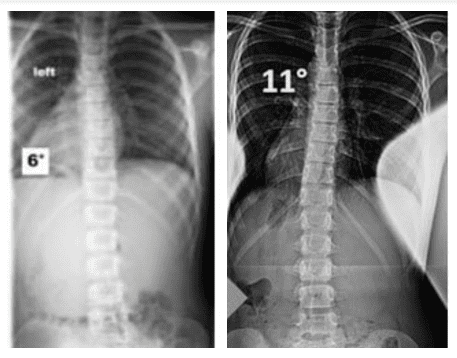
Mild scoliosis treatment
The standard medical approach is to monitor the curve size at regular intervals and only intervene if the curve becomes larger than 25 degrees.
There are, however, more and more studies that show the risks of the “watch and wait” approach, and show the benefits of early detection and treatment.
While treatments do exist, many pediatricians and general practitioners are simply not aware of them. They are only trained to refer mild scoliosis patients to orthopedic surgeons, who will advise surgery once the curve reaches a certain level of severity.
There is something you can do!
The most damaging misconception about mild scoliosis is that there is nothing you can do to treat it, or worse, that there is nothing you SHOULD do. Postponing or foregoing early-intervention treatment for scoliosis to “watch and wait” increases the risk of progression and complications.
The image below shows a series of X-rays of a untreated child with scoliosis. From age 9 to age 13, the child followed-up with their doctor at regular intervals and was re-x-rayed each time. From the image you can see that in just 4 years the upper curve progressed from 3° to 48° and the lower curve progressed from 6° to 43°.
For adult cases, curve progression will vary between 0.5 to 3.0 degrees per year. This variance depends on the shape of the curve, curve size, and age of the patient at the onset of the scoliosis.
Why treat mild scoliosis now, rather than later?
To put it simply, small curves are easier to treat. Research shows that mild curves respond well to scoliosis exercises and in the majority of cases, without the need of scoliosis bracing. To achieve these results, it is imperative to remove the factors that progress a scoliosis before the scoliosis reaches 30 degrees. A custom designed treatment program of targeted stretching, neuromuscular re-education, active self correction techniques, along with isometric and isotonic “yoga for scoliosis” exercises can stave off the forces driving curve progression.
It can be nearly impossible to tell a person has scoliosis just by looking at them, especially mild scoliosis. Patients with 70 degree curves can appear perfectly aligned on the outside and on an x-ray reveal a spine resembling a compressed letter “S”. While scoliosis appears as a side-to-side curve on an x-ray, it is actually a twisting of the spine that causes the rib cage to rotate as well. The effect becomes visible in some patients when the rib cage is pushed to one side causing a “rib hump.” These visible changes can occur before treatment is even recommended. If treatment is initiated while the curve is still small there is a far greater chance of a successful outcome.
Can Mild Scoliosis be Corrected?
Our custom-designed home based scoliosis specific exercise programs work to reverse mild scoliosis curves in patients of all ages and levels of progression.
Precision X-Rays
In order to create the most effective custom treatment plan, a detailed physical examination is performed including any necessary X-rays. Unlike other treatment approaches, the custom designed home based exercise solution has a holistic philosophy: we believe in addressing the cause and not the scoliosis symptoms. This involves pinpointing causes originating from outside the spine. In addition to the typical panel of physical examinations we add in lung function testing, range of motion evaluation, laser scanning of the arches of the feet, biochemical evaluation, balance and proprioception testing, computerized postural assessment and other assessments. All the information collected from the examinations work to identify the underlying drivers of the scoliosis. This is one of the unique aspects of this solution, and it often allows patients to see quicker and more dramatic results.
Scoliosis Treatment Plan in 3 Steps
Step 1: Mix
The “mix” step is the warming up of the spin in preparation for the correctional exercises to come. It sets up the spine for structural changes by warming up the inter-vertebral discs, making them flexible and mobile. Just like cold silly putty is difficult to manipulate, so the discs between vertebrae are inflexible and rigid when not properly stimulated.
Here are some of the elements of this step:
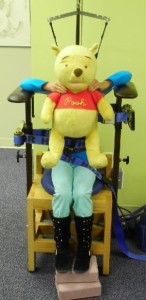
- The Wobble Chair – A treatment chair that sits on a ball-and-socket joint and flexes in every direction to put the spine through a full range of motion.
- Cervical Traction – A self-administered traction that pumps the body’s own fluid and nutrients into the discs of the neck.
- Vibrating Traction – Uses a slow, relaxing vibration intended to relax the ligaments and soft tissues of the spine.
- Eckard Flexion/Distraction Table – A special motorized table with belts that pull (not push) the scoliotic curves out of the spine.
- Spinal Decompression Table – A type of traction therapy in which the spine is stretched and relaxed intermittently in a controlled manner typically in adult mild lumbar scoliosis treatment.
Step 2: Fix
Once the inter-vertebral discs are warmed up, it’s time to move on to correcting the spinal curves.
The adjustment phase of the treatment uses instrument-assisted adjusting using the minimum amount of force necessary to make the correction. This allow the patient to experience no pain from the treatment, even as new muscle areas are being strengthened.
The adjustment phase is different for every patient and based on their initial X-rays and a specialized chiropractic examination of the spinal joints. The effectiveness of the treatment plan is confirmed with the follow-up examinations at regular intervals.
Mechanical adjusting instruments and specialized drop pieces enhance the precision and effectiveness of chiropractic care, while also reducing the amount of force required to correct the spine. The application of these adjustments, or precision manipulations, are correlated with the information obtained from the patient’s x-rays, computerized posture analysis, and physical examinations. We avoid “cracking” the neck! The adjustments are gentle and painless.
Step 3: Set
Immediately after the adjustment phase of the treatment, a final step sets the treatment in place, allowing for permanent change that can be built upon in future treatments. This involves:
- Spinal weighting protocols (typically on the head, torso, and hips).
- Whole-body vibration therapy, also known as Neuromuscular Re-education (NMR), such as the Whole body vibration plate and the Scoliosis Traction Chair.
- Gait therapy which re-trains patterns of moving and walking.
Mild Scoliosis Exercises
The final step in the treatment program is to do a scoliosis exercises program at home.
The custom designed program requires at-home exercises once or twice daily in order to see results. The treatment process is one that must be actively and consistently followed by the patient. Together, office treatments and at-home exercises will allow you to see improvement in your scoliosis that you thought was not possible.
The development of the treatment has two frequency options, both of which have two main parts: the standard frequency of twice weekly visits over 2-3 months (approximately 90 minutes per visit) OR the intensive treatment plan (1-2 weeks of 3-5 hours per day, 5 days a week). Both frequency options include customized, at-home exercises to be completed once or twice daily. The length of your treatment depends on the severity of the curve, amount of degeneration, level of pain being experienced, location and shape of the scoliosis and age of the patient.
If you choose to take the intensive program option (typically for patients who live over one hour away from a center OR who prefer to get a quick jump start on their treatment program), your treatment schedule will look like this:
- Curves LESS than 25 degrees, (low pain levels, minor degenerative changes) typically require a 1-week intensive course.
- Curve MORE than 25 degrees, typically require a 2-week intensive course.
Mild Scoliosis Bracing
I wanted to make a final notes about bracing for mild scoliosis, as I am sometimes asked about this. There is rarely any need to brace a mild scoliosis. The beauty of catching the curve when it is small is that custom designed scoliosis specific exercises can comprise the whole treatment plan. If there is an indication for bracing, it would be nighttime only for a child, and 4 hours per day for an adult. This pattern of brace wear is much easier to deal with, especially for the younger scoliosis patient.
Conclusion
Remember that there is something you can do. Don’t be afraid to ask questions, and don’t be afraid to get a second opinion.
Do your own research and take your healthcare into your own hands.
Experience the hope and relief that thousands of scoliosis sufferers have experienced with our treatment plan. It is my pleasure and passion to help patients of all ages and stages of scoliosis to finally have a solution that they didn’t believe was possible.
Don’t pass up this opportunity. Don’t experience regret when the curve progresses in the future. And most importantly, don’t listen to well-meaning medical professionals who say that there is nothing you can do.
Begin by calling us today. There is no charge to discuss your case or your child’s case and no question that is not worthy of your call.
(845) 624-0010


